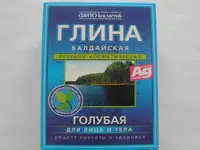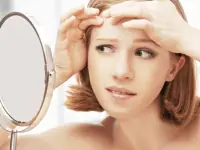Rashes in the chin area often become an aesthetic problem, causing both women and men a lot of trouble.
Heredity, lifestyle, diet, bad habits and personal hygiene are important factors that can predispose to the appearance of acne on the chin.
Features of acne on the chin
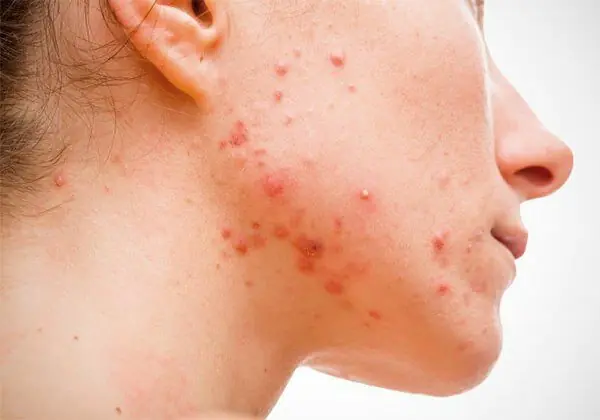
The cause of a chin rash is the inflammatory process around the sebaceous plug (comedone) and the formation of an inflammatory tubercle.
Comedones can be closed (milia) or open.
Open comedones are typical acne lesions in which the top of the sebaceous plug becomes a black spot due to its oxidation under the influence of oxygen.
Closed comedones look like white nodules under the skin, which, when a subcutaneous inflammatory process develops, appear as painful red pimples.
Due to the fact that the skin on the chin is dense, it is difficult for inflamed comedones to find a way to the surface, but when the pressure in the inflammatory capsule of the milia gradually increases, it breaks out in the form of a white or yellowish pimple with an outer inflamed rim. Therefore, the appearance of acne on the chin can be a manifestation of skin diseases - acne, seborrhea, or dermatitis, as well as other diseases.
Why do they appear?
The causes of their occurrence are skin and somatic diseases, therefore, if persistent rashes appear on the skin in the chin area, you must immediately consult a dermatologist in order to determine the cause of their appearance and begin adequate treatment in a timely manner, and in the future to avoid increasing health problems.
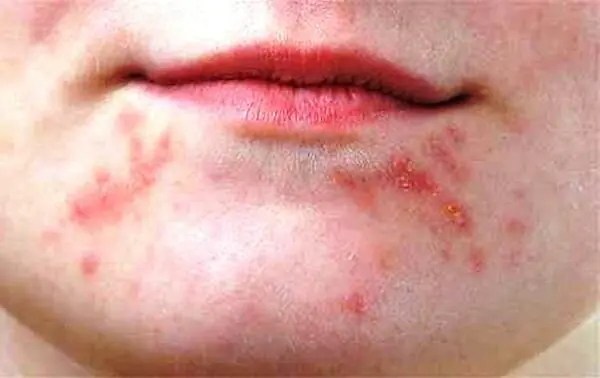
Many doctors associate the appearance of acne on the skin of the chin with frequent colds and hypothermia. And this is true, indeed one of the reasons for the occurrence of persistent rashes on the chin is a decrease in immunity, due to the activation of one’s own pathogenic microflora. As a result, there is the development of pustular infections caused by staphylococcal or staphylococcal flora with localization of the pathogen not only on the skin, but also in the oral cavity or nasopharynx, which manifest themselves in the form of staphylococcal or streptoderma on the skin of the chin.
Also, the cause of acne on the chin can be inflammatory diseases of the ovaries, which, if left untreated, are complicated by polycystic disease. The development of polycystic ovary syndrome can be activated by severe or severe respiratory infections, as well as by the presence of chronic inflammatory diseases in the body (sinusitis, tonsillitis or widespread caries). Disruption of the ovaries causes hormonal imbalance in a woman’s body, which causes acne on the chin. You need to start the examination by contacting a gynecologist, and if necessary, an endocrinologist and additional examination methods (taking tests to determine the level of sex hormones, ultrasound).
Pathology of the gastrointestinal tract is also one of the likely causes of acne in the chin area. Impaired digestion and absorption due to fermentopathy or the presence of parasites lead to the formation of toxins in the intestines, which are partially eliminated from the body through the pores of the skin. And when a large amount of toxins accumulates in them, inflammation of the skin around the sebaceous glands occurs. Therefore, you need to carefully understand the cause of rashes on the skin of the chin and, depending on the pathology, prescribe treatment.
How to treat acne on the chin
Treatment of the underlying disease that causes the appearance 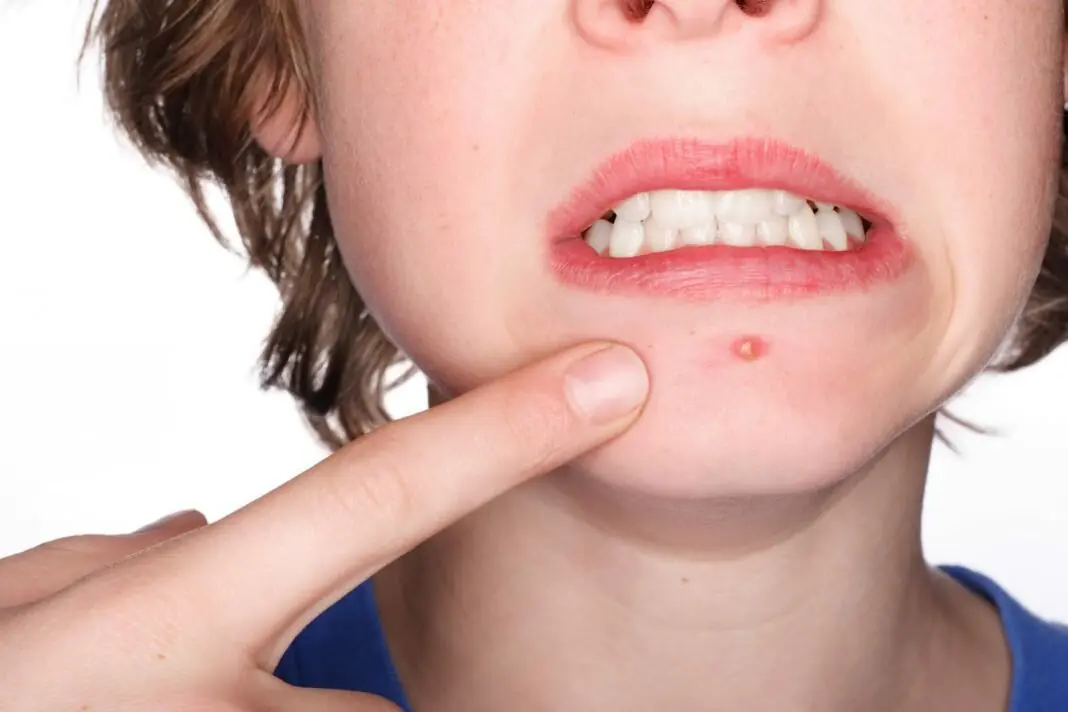
rash on the chin is very important, because cosmetic procedures and products will give a temporary effect, and if a somatic pathology causing the rash is detected, the treatment will be comprehensive, aimed at all parts of the pathogenesis - eliminating the main cause that provoked the rash and local treatment of the rash with cosmetics.
If it is ordinary acne, then, first of all, you need a balanced diet. The diet should be dominated by vegetables, dairy products and fruits, excluding smoked foods, fatty foods, eggs, strong coffee and tea, as well as sweets.
It must be remembered that self-medication and uncontrolled use of various medications (hormonal or anti-inflammatory ointments, antibacterial drugs or immune system stimulants) can lead to an aggravation of the process, the accumulation of allergic reactions, and the formation of scars.
Only a doctor - a dermatologist or cosmetologist, having examined in detail and established the cause, will prescribe adequate and effective treatment.
One of the effective ways to get rid of nodules and scars on the skin of the face is ozone therapy, which has a beneficial effect on the condition of the skin. This is a cosmetic procedure in which the face is treated with an ozone-oxygen mixture that has antimicrobial properties, and this helps improve the regeneration of skin cells.
Basically, in the treatment of acne on the chin, traditional methods of treatment are effective and safe, aimed at reducing inflammation, cleansing and moisturizing the skin of the face, and generally strengthening the body through the mild immunostimulating effect of plant extracts of medicinal herbs.
Traditional medicine
Medicinal plants that are used to treat inflammatory skin diseases: acne, seborrhea, or dermatitis, which are accompanied by the formation of milia or typical acne on the skin of the chin, can be divided into the following groups:
- anti-inflammatory medicinal plants that have a local effect on the inflammatory process and cleanse the skin - sage, yarrow, chamomile, eucalyptus, calendula, St. John's wort;
- immunostimulating and restorative medicinal herbs - linden blossom, ginseng, Chinese lemongrass, oregano and rose hips;
- regenerating and absorbable medicinal herbs - aloe, nettle and plantain.
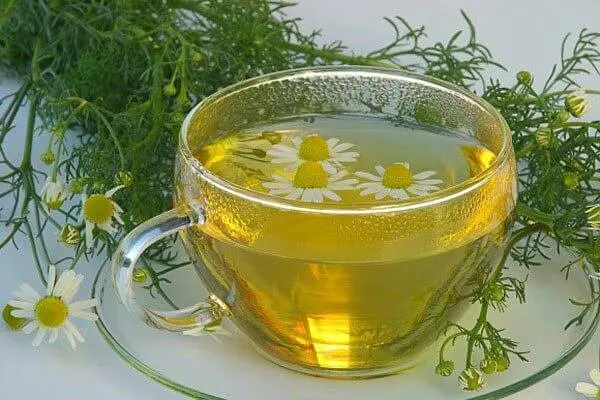
To treat cough and rash on the chin, infusions and decoctions of these medicinal herbs are used in the form of washes, compresses, steam baths and for oral administration. Most often, herbal teas are used that combine herbs with different effects - anti-inflammatory, tonic and regenerating components.
An example is a very effective collection of herbs both for oral administration and for washing and steam baths.
To prepare this collection, you need to mix equal quantities (a teaspoon each) of the following medicinal herbs in a clean and dry container: plantain and nettle leaves, linden blossom, chamomile and calendula flowers, eucalyptus leaves, as well as several crushed rose hips. Two tablespoons of the collection must be poured into a liter of boiling water in an enamel bowl, boiled for ten minutes in a water bath, and then left for half an hour. This decoction is taken orally, a quarter glass 2 times a day. It improves metabolic processes, has antitoxic and restorative effects. Additionally, before each dose, you can add 10 drops of tincture of Schisandra chinensis or ginseng, which are excellent herbal stimulants of the immune system.
Steam baths with herbal infusions open and cleanse the pores of the face. To do this, you need to take two tablespoons of a dry mixture of anti-inflammatory herbs (dried chamomile flowers, sage herb, yarrow or nettle) per liter of water, boil it for five minutes in a wide bowl over low heat. Wash your face clean first, and when the broth is ready, tilt your face over a bowl and steam the skin for ten minutes. To prevent steam from escaping, you need to cover yourself with a towel. Comedones that have come to the surface (this requires several procedures) are carefully removed with a sterile bandage moistened with any disinfectant solution (hydrogen peroxide or chlorophyllipt). It must be remembered that you should not squeeze out acne - this leads to inflammation and the formation of deep scars, which are very difficult to heal in the future.
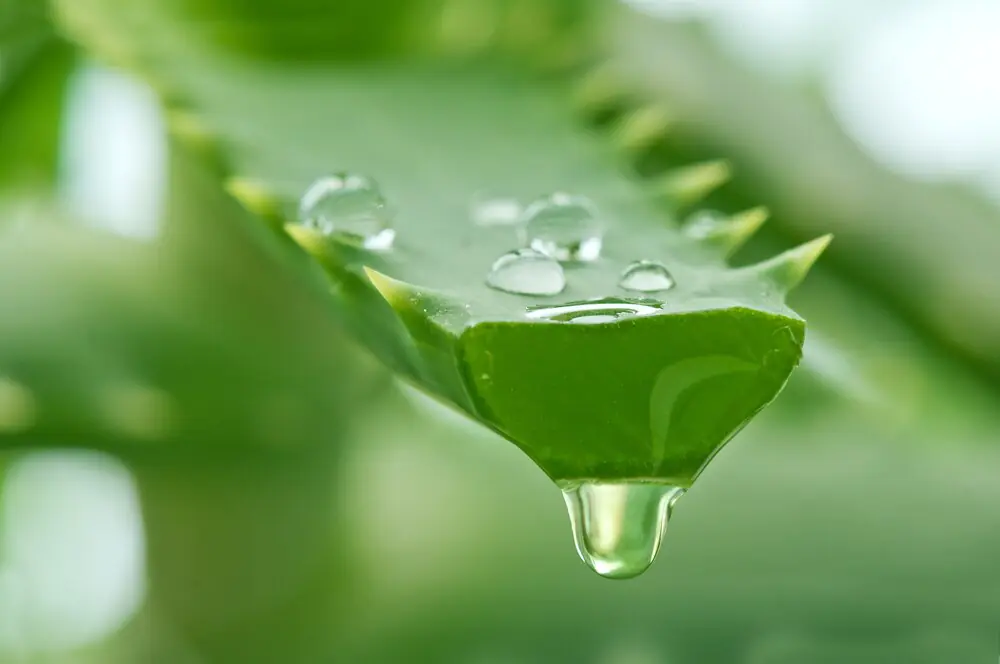
A compress of fresh aloe juice applied for a few minutes will quickly and effectively help get rid of acne on the chin. Aloe is an excellent anti-inflammatory and antimicrobial herbal remedy that stimulates natural skin regeneration.
Also, the appearance of small pimples on the chin can be a manifestation of a negative response to cosmetics. Therefore, you need to temporarily give up any cosmetics, in particular fatty night creams and foundations that can clog pores, and in the future use cosmetics marked “non-comedogenic.”
It is important to remember that the occurrence of acne on the chin must be treated comprehensively, after consulting a specialist, conducting a full range of examinations and determining the cause of their occurrence.
pediatrician Sazonova Olga Ivanovna
Acne is a serious inflammatory skin disease. It occurs in the so-called pilosebation structures of humans. These structures consist of sebaceous glands and hair follicles.
History of the term
The term that defines a disease such as acne in teenagers appeared in Ancient Greece. It was first mentioned in the works of Aetius of Amida, who worked as a physician for the Byzantine Emperor Justinian I in the 6th century AD.
The very concept of “acne” is a derivative of the ancient Greek concept, literally translated meaning “height, blossoming, edge.”
Causes of the disease
Experts identify several reasons why acne occurs in teenagers. Treatment is possible, but requires diligence and careful compliance with all doctor’s instructions.
One of the main causes of acne is heredity. Doctors also highlight hormonal activity during adolescence, when girls begin their menstrual cycle, and acne in teenage boys appears during puberty.
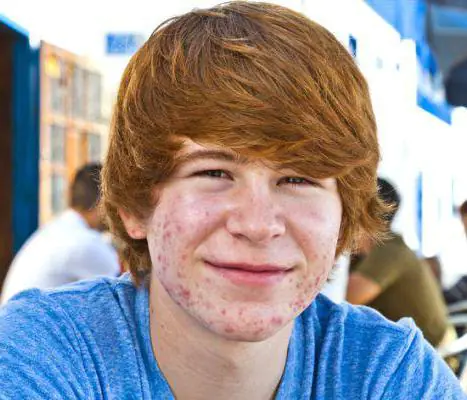
Acne can also occur due to problems with the gastrointestinal tract, stress, overactive sebaceous glands, a large accumulation of dead skin cells, and can also be a consequence of the use of anabolic steroids, as well as drugs containing halogens.
Among doctors, the most common version was that acne in adolescents occurs solely as a result of hormonal activity. However, later scientists found that the disease is provoked by many hormones. In particular testosterone.
In the post-pubertal period, acne in teenage girls is rare. In this case, it is already a symptom of a serious disease, for example, Cushing's syndrome. At the same time, excess carbohydrates in the diet lead to skin defects.
Classification of the disease
To figure out how to help with this problem, it is important to understand what kind of acne occurs in teenagers. Treatment will vary depending on the type of disease.
Doctors identify several main forms. Firstly, comedonal. It is characterized by the appearance of closed pimples on the chin, forehead and wings of the nose. In this case, inflammatory processes, as a rule, do not occur.
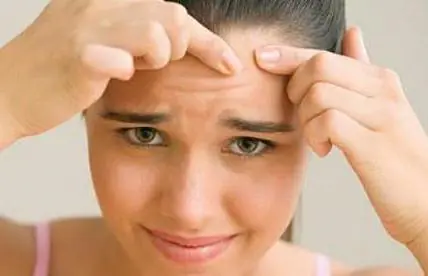
Another form is papulopustular. It is manifested by the appearance of purulent formations, both open and closed. At the same time, the number of pustules is small.
Acne in teenage boys often appears in a nodular form. Their characteristic location is on the forehead, chin, nose and cheeks. In this case, at least 25-30 pustules appear.
The most problematic is the severe form. In this case, teenage acne merges with pustules, deep and painful nodules appear, and large areas of the skin become inflamed. If you do not provide timely assistance, this form is fraught with the appearance of scars on the skin.
Clinical picture
Doctors identify a wide variety of types of rashes and acne in teenagers. Treatment is possible; in most cases, not even traces of the disease remain on the skin. In addition to the face, inflammation can appear on the chest, especially in the upper part, and on the back. After all, it is in these areas that the largest sebaceous glands are located. Acne also provokes inflammatory processes, which cause purulent formations.
Purulent blisters, which experts call pustules, dry out after opening. This also causes crusts to form, leaving noticeable scars.
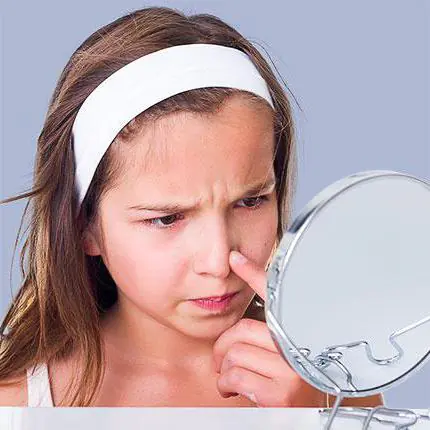
There are several types of acne scars. The most dangerous and unpleasant ones are deep, with the formation of characteristic skin acid.
Angular scars most often appear on the temples and cheeks. They are very similar to the effects of chickenpox. Keloid scars may also occur.
In general, the clinical picture is varied for adolescent acne. Treatment can be painful and the process can take many years.
Symptoms
Most often in adolescence, a disease occurs that has the Latin name acne vulgaris. Teenagers 14 years old are especially susceptible to this form. It occurs due to excessive secretion of sebum by the glands, which clogs the pores. The accumulation of these elements occurs due to disruption of the keratinization process. It is also called keratinization, when cells die in the epidermal layer of the skin.
Ultimately, all this leads to exfoliation of skin cells. Sebum is concentrated under the pores blocked by the disease. All these factors create a favorable environment for the proliferation of harmful microorganisms.
Bacteria that causes acne
With acne, the pores of teenagers become inflamed due to the proliferation of bacteria, the most dangerous of which is propionibacterium acnes. It feeds on fatty acids in sebum. It got its name from a derivative of one of the metabolites - butyric acid.
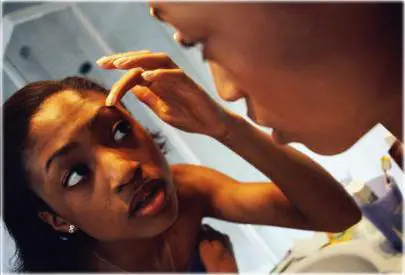
The bacterium is very sensitive to antibiotics from the tetracycline group, and fluoroquinolong drugs are also used to combat it. One of the most popular among them is Adifloxacin.
Ultraviolet rays fight bacteria well. Also, some doctors recommend the use of aminolevulinic acid. However, it often causes side effects in patients.
Most often, this bacterium affects the face and upper neck, although there are exceptions. Among the rare manifestations that this bacterium can cause is the formation of purulent and sebaceous cysts. They can leave scars on the skin.
Acne treatment
Treatment of acne in teenagers requires patience and endurance; it will not be possible to overcome this disease overnight. The main task is to eliminate the root cause - seborrhea.
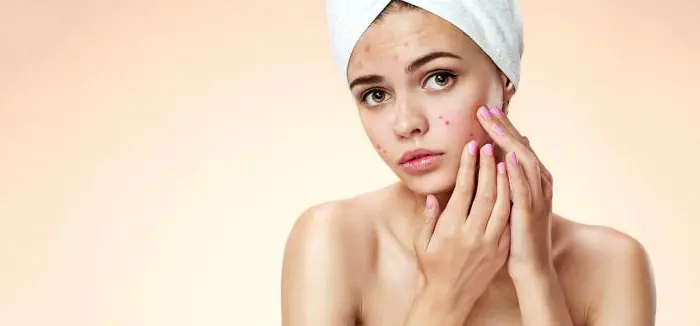
This is a painful condition of human skin caused by extremely strong sebum production. Such problems arise due to violations of one or several functions of the sebaceous glands of the skin. For example, nervous or endocrine.
Clear signs that a patient has seborrhea are oily shiny skin, itching, flaking, hair loss and dandruff. It can also manifest itself as a thickening of the stratum corneum of the epidermis.
To get rid of this disease, use the following products: Selenium disulfide, Ketoconazole, and Lithium succinate. Before using medications, you must consult a doctor.
Use of antibiotics
Often the best treatment for acne in teenagers is antibiotics. They are necessary in severe cases of the disease. In former times, they used means whose effectiveness has not yet been proven. This includes transfusion of the patient’s own blood, estrogens, wiping with a solution of salicylic acid, ultraviolet irradiation, and cryotherapy.
To effectively combat acne, it is necessary to remove comedones - a special type of cysts that appear when the hair openings are blocked by horny masses. This may be desquamated epithelium along with thick fat. The acne is then opened.
Effective techniques
To combat acne, experts use disinfection. This is the process of removing the blackhead's fat core using vacuum or galvanization.
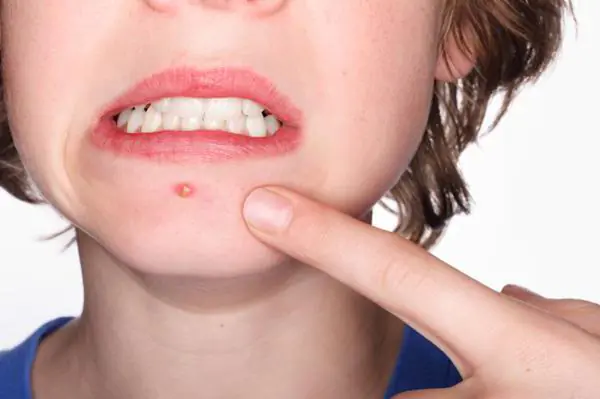
Galvanization in physiotherapy involves direct exposure of the patient's body to a constant and continuous current of low strength and voltage. The purpose is exclusively therapeutic and prophylactic. Galvanization is carried out through contact electrodes placed on the patient’s body; they should come into contact with problem areas of the skin that are most susceptible to disease.
Acne prevention
In order to prevent the appearance of juvenile acne and rashes in adolescence, an important preventative point is the timely treatment of seborrhea.
There are also several other key factors that will save you from such diseases. This is adherence to the regime. It is necessary to devote enough time to sound, healthy sleep and lead an active lifestyle. Spend as much time as possible in the fresh air, walk more often, and do not forget about physical exercise.
An important element of acne prevention is following a strict diet. If you want to defeat teenage acne, then categorically exclude fats, especially refractory fats, and oils from your diet.
Many experts recommend using zinc-based medications as a preventative measure. This substance inhibits the activity of the sebaceous glands, the likelihood of subsequent inflammation is gradually reduced to zero.
How was acne treated in the past?
For many centuries, humanity has tried to find an effective and high-quality method of treating acne. People have faced this problem throughout their history.
Even in ancient Rome, teenagers used special baths and drank mineral water to combat acne. In the 19th century, sulfur was actively used to treat acne and pimples. In the 1920s, doctors adopted benzoyl peroxide. This is a special organic compound, the use of which, however, has not confirmed its effectiveness. In the 1930s, American doctors fed their patients laxatives to combat acne.
It was only in the 1950s that antibiotics began to be used. In the 1960s, tretinoin began to be actively used. This is a pharmacological drug containing a large amount of vitamin A. It not only has an antiseborrheic effect, but also helps to cope with tumors and local inflammation. It is often used to reduce the number of wrinkles. The desired effect is achieved by enhancing the regenerative function of cells and their subsequent renewal.
On the market today you can find many different drugs containing tretinoin. For example, there are very effective and efficient acne creams.
Modern drugs
Since the 1980s, doctors have been actively using the drug Isotretinoin. This drug is a real salvation for many dermatological diseases. At its core, it is a structural analogue of vitamin A.
For acne, the mechanism of action is as follows. The drug first reduces the thickness of the upper layer of the epidermis. As soon as it hits the skin, it begins to weakly affect the cells of the stratum corneum. Because of this, they peel and flake. A peeling effect occurs. Thus, the thickness of the stratum corneum of the epidermis is reduced as much as possible. This is useful, because it consists mainly of already dead cells. This process opens the pores of the skin, which prevents the formation of blackheads or oil plugs.
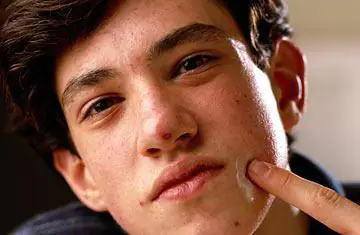
Next, the drug applies its comedolytic properties. It dissolves fatty plugs, due to which skin pores are constantly clogged. The skin is freed from acne. In addition, it is an effective prevention of acne formation during adolescence.
Isotretinoin also minimizes the activity of the sebaceous glands. But this is one of the main factors that cause acne, pimples and pimples. Increased activity of the sebaceous glands ultimately leads to the fact that the ducts open, and an increase in the production of fatty secretions provokes clogging of the pores.
"Isotretinoin" can most effectively normalize the function of the sebaceous glands and reduce their secretion.
In the 1990s, clinics began to actively use laser systems to combat acne.
Anti-acne drugs
Today on the shelves of pharmacies you can find a large number of drugs, with varying degrees of success, allowing you to fight acne.
These may be local bactericidal agents. They are used for mild forms. However, frequent use of such products leads to excessive dryness of the skin, irritation and redness.
Local antibiotics, such as Erythromycin, as well as tetracycline antibiotics, are used externally.
Antibiotics such as Doxycycline and Limecycline are suitable for oral administration; sometimes dermatologists prescribe Trimethoprim.
In recent years, hormonal therapy has become actively used. It is especially effective for women. The drugs must be taken in combination. For example, estrogen together with progestogen.
Many retinoids, especially those contained in gels and ointments, have been proven effective. For example, these are “Effezel”, “Klenzit”, “Isotrexin”.
Retinoids are also used internally. The need for this arises in severe forms of acne. In this case, dermatologists prescribe Isotretinoin to the patient.
Such a popular method as phototherapy has proven itself well. For treatment, special lamps or a laser are used, with the help of which the effect of local sterilization of inflammation is achieved.
In rare cases, dermatologists also use azelaic acid (usually for mild forms of the disease) and zinc to treat acne.
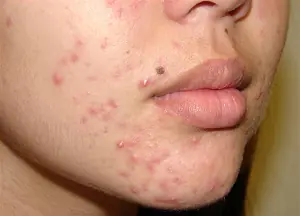
Acne on the chin is not only a noticeable cosmetic defect, but also evidence of a malfunction in the body. Internal problems are immediately reflected on the skin.
The number of pimples, their size, and the degree of inflammation depend on various factors. Often, large areas strewn with ulcers appear on the chin. You need to fight acne correctly. For you - recommendations from cosmetologists.
Causes
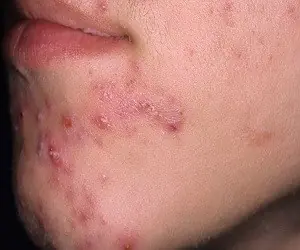
Why do acne appear on the chin, open inflamed comedones? Unaesthetic rashes are a consequence of improper functioning of the sebaceous glands, the accumulation of sebum at the mouths of the hair follicles.
The main causes of acne on the chin:
- hormonal imbalance. This factor provokes rashes in women, men and adolescents;
- During puberty, hormonal changes occur in the body. Juvenile acne is common;
- in women, malfunctions of the ovaries, one of the “building blocks” of the endocrine system, are reflected on the face;
- poor nutrition. Excess salty, fatty, sweet, spicy foods, addiction to flour, fast food, coffee and soda cause disruptions in the functioning of the gastrointestinal tract. The result is acne, open and closed comedones;
- depletion of the immune system. With hypothermia, viral infections, frequent colds, the number and area of rashes increase each time;
- an increase in the level of steroid hormones in women on the eve of the next menstruation;
- low-quality skin care products that clog the ducts of the sebaceous glands;
- excess “heavy” decorative cosmetics – foundations, powders, use of high-density formulations;
- lipid metabolism disorders, excess weight, diabetes mellitus;
- high air humidity plus high temperature are excellent conditions in which the skin cannot dry out. Under such weather conditions, ulcers often plague owners of oily epidermis;
- if you gain extra pounds along with the appearance of comedones and the growth of body hair, be sure to get examined to rule out polycystic ovary syndrome;
- excessive keratinization of the epidermis or hyperkeratosis is another factor influencing the number of rashes.
Other causes of chin rashes:
- bad habit of supporting your face with your hands;
- chronic lack of sleep, stress;
- helminthic infestations;
- alcohol abuse;
- smoking;
- insufficient facial hygiene.
Now you understand what acne on the chin means and why if you have profuse rashes, you can’t do without consulting a specialist. Don't self-medicate! You can drive the problem very deep.
In severe, advanced cases, acne can take years to treat. The inflammatory process can spread to healthy tissue.
Treatment methods
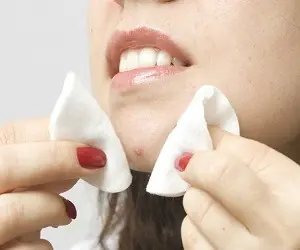
Any therapy begins with diagnosis. The appearance of internal acne in the chin area is a signal for a full examination of the body. A single comedon is the result of irritation of a certain area of the epidermis. There's no need to panic.
Multiple rashes are a reason to visit:
- dermatologist;
- gynecologist (urologist);
- endocrinologist;
- gastroenterologist.
The specialist will find out if there is a problem in his profile. No ointments or creams will help if you don’t understand what causes the appearance of comedones and subcutaneous pimples on the chin.
Complex therapy will help put the skin in order. Doctors use:
- traditional methods;
- special ointments, pimples for acne;
- restorative drugs;
- physiotherapeutic procedures;
- diet;
- special care for the epidermis.
Can't do without:
- healthy lifestyle;
- control of chronic diseases.
Find out about the properties and uses of blue clay for skin and against cellulite on our website.
How to get rid of irritation after shaving your legs? Read the answer at this address.
Proper nutrition
How to get rid of acne on the chin? Without changing your diet, pimples will haunt you for a long time.
Recommended:
- fermented milk products (in moderation);
- vegetables, fruits, herbs;
- porridge;
- lean meats;
- herbal decoctions, mineral water;
- vegetable oils.
Exclude:
Medications
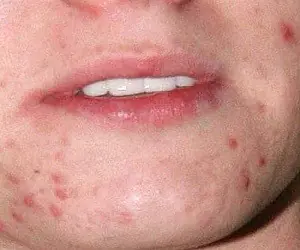
Use less widely advertised ointments and creams that allow you to “get rid of rashes in a week.” This is often a waste of money.
After consultation, the dermatologist prescribes proven medications:
- if most of the chin is covered with comedones and pustules, use an effective drug with benzoyl peroxide - Baziron AS. This remedy has helped many people for acne; (We have a separate article about Baziron for acne);
- Zinc ointment dries out pimples well and relieves inflammation. It is recommended by many people for acne and has improved the condition of problem skin; (Zinc ointment for acne is written about in this article);
- did your doctor write out a prescription for an acne powder? Don't refuse! These products are inexpensive, the effect after use is excellent; (About tsindol - an acne talker - written at this address);
- You can make mash yourself. In a container, combine 50 ml of medical alcohol and boric acid, add 5 g of 2% salicylic acid and chloramphenicol. Before going to bed, lubricate each pimple, shake before use;
- another recipe for an effective chatterbox. Combine 50 ml of boric and salicylic acid (both compositions are 2% concentration), add 4 g of erythromycin and zinc oxide. The method of application is similar to the previous composition. After the procedure, wash your face and apply moisturizer.
Traditional methods and recipes
Compresses, lotions from decoctions of medicinal herbs:
- improve the condition of the epidermis;
- reduce inflammation;
- remove excess sebum from the surface of the epidermis, from clogged hair follicles;
- dry out inflamed comedones;
- prevent the appearance of new rashes.
To combat ulcers, closed and open comedones, prepare a mixture. Combine 2-3 types of herbs. A decoction of one type of medicinal raw material is suitable.
How to use the decoction:
- for 1 liter of hot water – 2–3 tbsp. l. raw materials. Boil it and let it brew. After an hour, strain the broth. Apply gauze soaked in healing liquid to your chin;
- soak a terry towel in warm broth and apply to your chin. After 10 minutes, wet the towel again and hold for the same time.
What causes acne on the forehead? We have the answer!
Find out everything about the treatment of trophic ulcers with folk remedies at this address.
Follow the link and read an interesting article about atopic dermatitis in infants.
How to get rid of white pimples on chin
Closed comedones are located in the deeper layers of the epidermis. From dense layers they have difficulty finding their way to the surface. Pressure in the inflamed hair follicle causes the white pimple to “bulge out.”
Getting rid of this scourge is quite difficult. It’s easier with blackheads (open comedones).
Steam baths will help ease the emergence of subcutaneous acne:
- prepare a medicinal decoction from a mixture of linden blossom and chamomile (take a tablespoon of each ingredient);
- pour 500 ml of water into the dry raw material, boil it, turn it off after 5 minutes;
- check if the steam is too hot;
- lean over the bowl, cover with a towel;
- after 15 minutes, wipe your face;
- Remove comedones that have come to the surface with a bandage wrapped around your finger. Be sure to treat the bandage with hydrogen peroxide;
- It is forbidden to squeeze pimples that have not released cloudy white pus;
- repeat the procedure every day until all closed comedones disappear.
Helpful Tips:
- Daily washing with a decoction of the string also dries out the epidermis and eliminates inflammation. The proportions and method of preparation are similar to the herbal decoction for compresses. The difference is that the decoction of the string is diluted by half with boiled water. You can store the healing liquid for 4 days in the refrigerator;
- A mask with white clay for acne is simple to prepare, and the effect is noticeable. Mix a tablespoon of powder with a teaspoon of filler. Aloe juice, a decoction of string or chamomile, and grated cucumber pulp are recommended. Keep the mixture on the affected areas for 15 minutes, wash. Apply light cream.
Acne on the chin in children
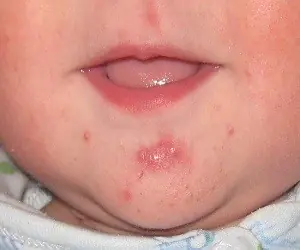
Rashes on the lower part of the face in babies are often associated with weaning the baby from the breast. These may be signs of an allergy or skin disease.
Be sure to visit your pediatrician. If necessary, your doctor will refer you to a pediatric dermatologist. Before visiting a specialist, do not apply any creams, ointments or folk remedies to the affected areas. Self-prescription of hormonal drugs is prohibited - the consequences can be very severe.
In older children, pimples in the chin area appear for the following reasons:
- poor hygiene, especially in hot weather;
- touching the face with dirty hands;
- excessive consumption of sweets, chocolate, baked goods, sweet soda, coffee, cocoa, drinks with dyes;
- stomach problems;
- metabolic disease.
In adolescence, the main cause of pustules is “hormonal storms.” Restructuring in a growing body leads to such a thing as juvenile acne.
Start treating pimples in children only after consulting a dermatologist and pediatrician. An individual approach is required.
Herbal decoctions are suitable for everyone. Pharmacy creams, ointments, and pimples for acne are prescribed taking into account:
- causes of skin lesions;
- age;
- individual characteristics of the body;
- number of rashes;
- neglect of the case.
Necessarily:
- change your son or daughter’s diet, don’t feed your children junk food;
- teach daily hygiene measures;
- stop touching your chin with dirty hands;
- strengthen the immune system;
- treat rashes with special compounds prescribed by your doctor;
- Give your child compresses and lotions with healing infusions.
Preventive recommendations
Avoiding the appearance of unsightly pimples in the chin area is easier than treating inflamed areas and fighting closed comedones. What will help you avoid this unpleasant phenomenon?
Remember:
- healthy lifestyle;
- proper nutrition;
- good sleep;
- giving up alcohol and cigarettes;
- careful facial care, especially at high temperatures and humidity;
- avoiding constant touching of the lower part of the face with hands;
- monitoring the condition of the body, timely detection and treatment of diseases of various organs;
- use of cleansing and moisturizing masks;
- washing with decoctions of medicinal herbs with anti-inflammatory properties.
Next is a video from the TV show “Health”. Elena Malysheva will tell you even more interesting details about acne on the chin:
Did you like the article? Subscribe to site updates via RSS, or follow updates on VKontakte, Odnoklassniki, Facebook, Google Plus or Twitter.
Subscribe to updates by E-Mail:
Tell your friends!
Treatment methods for acne on the chin: effective medications and traditional recipes: 6 comments
Lotions with Polysorb help me fight acne. It removes redness and oily shine. Dries out pimples and tightens wounds.
Cindol is very helpful for acne. It not only perfectly dries out existing pimples, but also prevents the appearance of new ones.
Pimples are fine, but I have trouble with the wounds after them when I squeeze them out ((
Rita, in such cases, I treat such wounds with an antibacterial cream - I use Argosulfan with silver ions in its composition - healing is accelerated quite well, and the wound itself is protected from infection. Double action, so to speak. By the way, no matter how much I use this cream, I noticed that from wounds with its use there is no trace left - no scars, no scars
Rita, I can advise you on my methods of struggle. There is a very good product called Klirvin and cream and lotion, I can’t find it anywhere on the Internet without them and read it, maybe they will help you.
Rita, I also use Argosulfan cream for such wounds and marks. The product is great, it exhibits 100% antibacterial properties - no infection gets into the wounds, and everything heals well with this cream, in a matter of days, leaving no traces.



